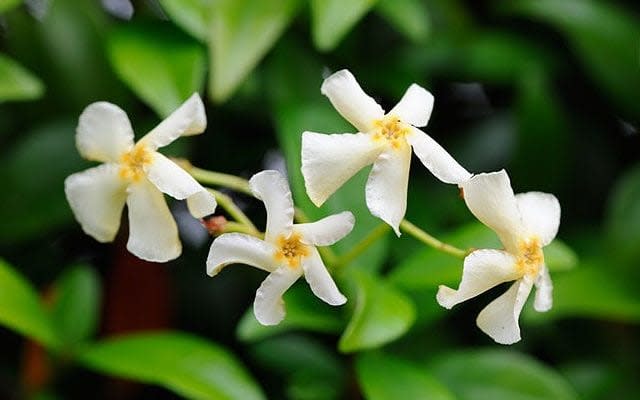Helen Yemm: plants for pergolas, the best rockery plants for a old bonfire site, two shrub questions

PERGOLA PLANTS
Janice Sayers has (rather cleverly) had a neat, timber pergola built to cheer up an otherwise rather plain aspect of her modern town house. She plans to furnish the bed in front with a mixture of shrubs and cottage garden plants, she says, but is reluctant to plant wisteria (her husband's choice) on the pergola, or anything else that would eventually be ladder/labour intensive. Clematis is a possibility, she says, but climbing roses, another favourite, are already covering an adjacent wall, so... what? Have I any ideas, she asks?
Janice could, of course, simply smother the whole thing with Clematis montana var. wilsonii, which, in addition to lighting up the garden with white flowers, would also fill the place with beautiful scent. And although a bit rampant, it flowers on new growth each year and would certainly be easier to control than wisteria. But why go for such predictable choices? Better, in my view would be Trachelospermum jasminoides (star jasmine), an evergreen climber with heavily scented summer flowers and wiry stems that could be persuaded to grow compactly upwards to cover the horizontal timber of the pergola.

Other uprights could be masked with evergreen shrubs of slim habit, pruned so as not to obscure the window. Variegated Italian buckthorn (Rhamnus alaternus 'Argenteovariegata') would work, as would a small-leafed ceanothus or even a shade-tolerant winter jasmine, pinned up so its flowers cascade down. All of these, while needing annual pruning (after flowering_ and a certain amount of tying-in, would be lower maintenance than a mass of tangled climbers, while also providing the shrubby element of the cottage-garden border in front.
Furthermore, their branches would, in time, make "climbing frames" for late-flowering viticella hybrid clematis (the sort you prune down to knee-height each year).
A BURNING PROBLEM IN THE ROCKERY
We are turning a 4ft 6in former bonfire site into a sort of rockery. Please could you tell if me aubretia would grow there (bonfires ended three years ago), and if not, which low-growing "rockery" type plants would work?
Heather Francis - via email
Over three years, the liming effect of your bonfires on the soil should to a large extent have been washed through by the elements. However, you should dig over the ground adding organic matter and a little sand if the soil is basically clay.
Most importantly, before planting, cleanse the area of weeds, particularly perennials that have the potential to tuck their roots deep under the rocks. On reflection, for such a small area, it might be simpler to use bought-in soil (John Innes No.3 with a little added multipurpose compost) in the planting spaces between the rocks.
You mention aubretia - so I am guessing that you favour a generally sprawly coverage of your rocks, rather than a gritty display of natty little alpines. Yes, aubretia will work, but be wary of its traditional companion, Cerastium tomentosum (snow-in-summer), which is barely controllable. More rewarding would be a mass of little colourful rock roses (helianthemums) and iberis (seek out a variety like 'Masterpiece'). These small, ground-hugging evergreen shrubs are much easier to maintain.

TWO VERY DIFFERENT SHRUB QUESTIONS
Eric Tose bought a half standard gooseberry bush (variety name presumably untranslatable) in Germany. It has been a great success and he wants to acquire another half standard but has failed to find one locally. Are they available here?
They certainly are - I can't imagine why anyone would grow a gooseberry that isn't a half standard since the vital trunk eliminates at least half of the pain of picking. Any time before March is a good time to plant, and Eric need look no further than Ken Muir. I bought two Ken Muir 'Invicta' half standards some years ago, and their crops were so heavy that I had to dig up one bush and give it away.
Charles Stewart's Magnolia stellata has been allowed to grow unchecked for 14 years. It has become rather congested and he has found "conflicting advice" on the internet about how and when to prune it.
He should carry out the work quite soon, while the shrub is dormant. Gently does it: the work should be spread out over a couple of years rather than in one fell swoop. Entire branches should be cut out to reduce bulk, with as little snipping/damage done to potentially flowering shoot tips on the the rest of the plant.



